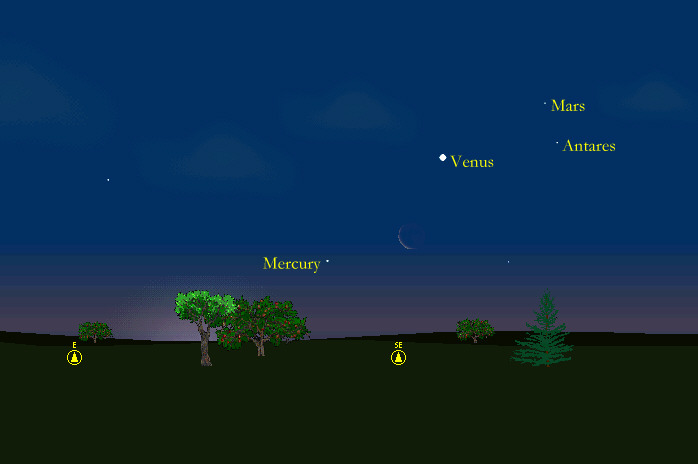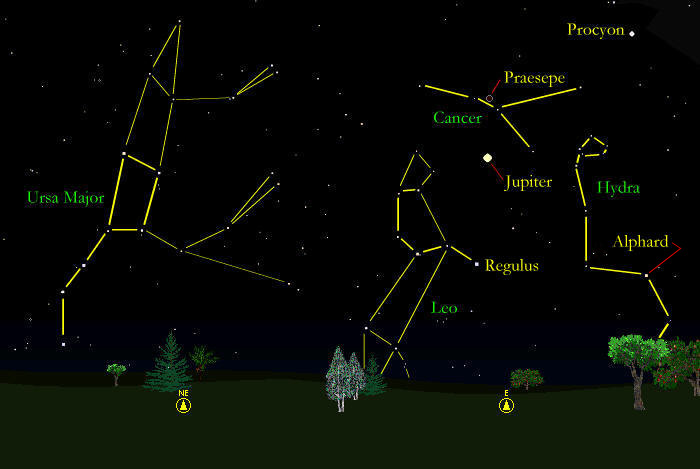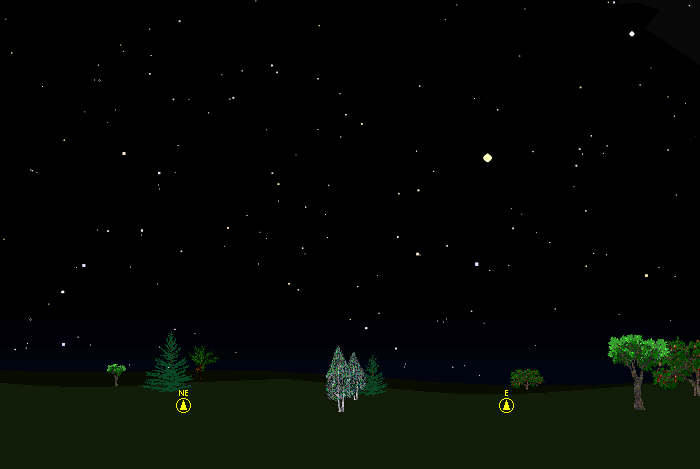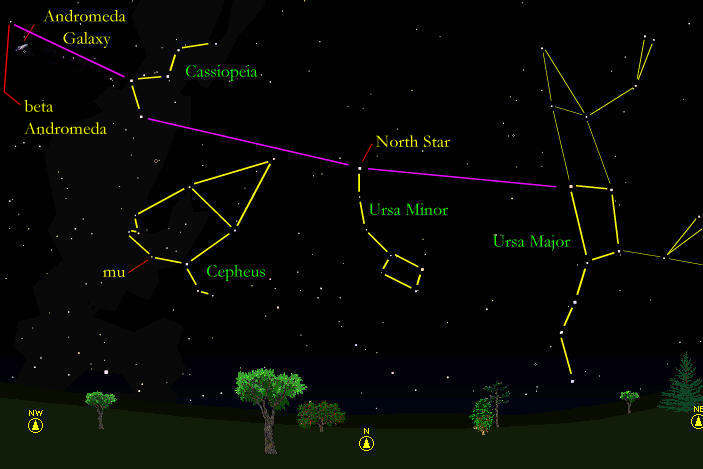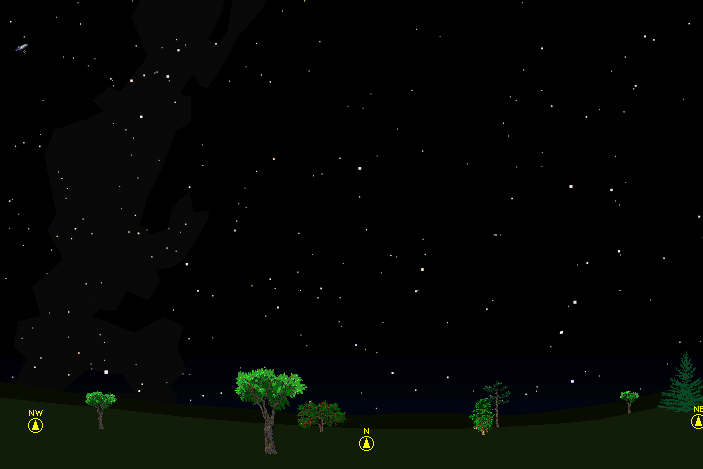The purpose of this new feature is to give scout leaders, educators and naturalists an idea of some of the natural events coming up each month. We will try to cover a variety of natural events ranging from sky events to calling periods of amphibians, bird and mammal watching tips, prominent wildflowers and anything else that comes to mind. We will also note prominent constellations appearing over the eastern horizon at mid-evening each month for our area for those who would like to learn the constellations. If you have suggestions for other types of natural information you would like to see added to this calendar, let us know! Note: You can click on the hyperlinks to learn more about some of the featured items. To return to the Calendar, hit the "back" button on your browser, NOT the "back" button on the web page. Sky Events: The Quadrantid Meteor Shower: This meteor shower peaks around midnight on the evening of January 3rd and the morning of January 4th. Since meteor showers are named after the constellation from which they appear to radiate, you may wonder where to look for this one. The stars that formed the old constellation Quadrans Muralis were incorporated into the constellation Bootes. Just watch the eastern sky after midnight. Evening Sky: As we said last month, both Jupiter and Saturn are magnificent this winter and a grand sight in any small telescope. At dusk at midmonth, Saturn is about 40 degrees above the eastern horizon. Jupiter rises about 6:30pm. Both planets are much brighter than the stars surrounding them, and both look a little larger than stars in 8x binoculars. The four "Galilean" moons of Jupiter are also sometimes visible in binoculars, provided you brace your arms against something steady. We had a nice view of the planet Mercury on Christmas Eve, and you can still catch it the first few days of January low in the southwestern sky after sunset. By month's end, it will have zipped into the morning sky and be well placed for viewing there.
Morning Sky: The planet Venus is dazzling in the morning sky before sunrise in January. It rises around 3:30am at midmonth. Faint Mars rises just before it about 2:45am. As mentioned above, Mercury, seen low in the western sky at the month's beginning, is well seen in the morning sky at the end of the month. Mercury, Venus, Mars and the thin, waning crescent Moon form a beautiful grouping on the morning of January 29th. The view below is for 6:15am, looking southeast. Compare Mars to the red giant Antares, just below it. The name Antares means, "rival of Mars." An unobstructed southeastern horizon will yield a better view.
All times noted in the Sky Events are for Franklin, Tennessee and are Central Standard Time. These times should be pretty close anywhere in the mid-state area. Constellations: The views below show the sky looking east at 9:00pm CST on January 15th. The first view shows the sky with the constellation outlines and names depicted. Star and planet names are in yellow. Constellation names are in green. The second view shows the same scene without labels. The planet Jupiter dominates the sky, with the faint constellation Cancer, the Crab, above it. See if you can spot the famous cluster Praesepe, "The Beehive Cluster," in Cancer above the planet Jupiter. Below and to the left of Jupiter is most of the constellation Leo, the Lion, with its bright star, Regulus. To the right of Jupiter, see if you can make out the head of Hydra, the Water Serpent. Its brightest star is Alphard, known as "The Solitary One" because of its somewhat isolated location from other bright stars. Finally, looking northeast, you can see the "Big Dipper" and the other stars that make up Ursa Major, the Great Bear.
The second set of views is looking north at 9:00 pm on January 15th. Find the "Big Dipper" first, and then use the "pointer stars" (see the view with text below) at the top end of the dipper to point you toward the north star. The north star is about 5 times the distance between the two pointer stars. If you continue in the same direction about the same distance on the opposite side of the north star you will come to the "broken 'm'" figure of Cassiopeia. Both of these constellations are visible most of the year, and you can use one to find the other, remembering they're always on opposite sides of the north star. The constellation Cepheus is below Cassiopeia. See if you can see the "glowing coal" color of the red giant star, mu Cepheus. The famous astronomer William Herschel called it the "Garnet Star." Finally, visualizing the sharper bend of Cassiopeia as the tail feathers of an arrow, look where the arrowhead might be and see if you can spot the reddish star beta Andromeda. Now look at a spot about 2/3 of the distance from the tail of the "arrow" towards beta Andromeda. Just below this spot is where you can find the Great Andromeda Galaxy. A dark sky is a big help here, but if you can't see it with the naked eye, try with binoculars. At a distance of 2 to 3 million light-years, it is the farthest object that most people can see with the naked eye. Simon Marius, in 1610, probably gave the best description of how it looks in a small telescope or binoculars. He said it looked, "like a candle flame seen through the horn window of a lantern." See if you can spot its soft glow.
On Learning the Constellations: We advise learning a few constellations each month, and then following them through the seasons. Once you associate a particular constellation coming over the eastern horizon at a certain time of year, you may start thinking about it like an old friend, looking forward to its arrival each season. The stars in the evening scene above, for instance, will always be in the same place relative to the horizon at the same time and date each January. Of course, the planets do move slowly through the constellations, but with practice you will learn to identify them from their appearance. In particular, learn the brightest stars (Like Regulus and Procyon in the scene looking east), for they will guide you to the fainter stars. Once you can locate the more prominent constellations, you can "branch out" to other constellations around them. It may take you a little while to get a sense of scale, to translate what you see on the computer screen or what you see on the page of a book to what you see in the sky. Look for patterns, like the stars of the "Big Dipper." The earth's rotation causes the constellations to appear to move across the sky just as the sun and the moon appear to do. If you go outside earlier than the time shown on the charts, the constellations will be lower to the eastern horizon. If you observe later, they will have climbed higher. As each season progresses, the earth's motion around the sun causes the constellations to appear a little farther towards the west each night for any given time of night. If you want to see where the constellations in the above figures will be on February 15th at 9:00pm CST, you can stay up till 11:00pm CST on the January 15th and get a preview. The westward motion of the constellations is equivalent to two hours per month. For instance, if you want to see what stars will be on your eastern horizon on April 15th at 9:00pm CST (3 months later), you would need to get up at 3:00am CST in the morning on January 15th (3 months times 2 hours/month = 6 hours). A good reference book for learning the constellations is the Peterson Field Guide, A Field Guide to the Stars and Planets, by Pasachoff. The book retails for around $14.00. A good beginners software program for learning the night sky is the Starry Night Beginner program. Visit the Starry Night web site at www.starrynight.com The program retails for around $30.00 and contains a wealth of information. Circumzenithal Arcs: Fall, Winter and Spring are good times to watch for these beautiful arcs that form directly overhead. Be sure to look upward in the late afternoon anytime you have wispy cirrus clouds in sky.
Amphibians: Contrary to popular belief, a lot of things happen with amphibians in January. To see them, though, you have to be out in the sort of weather that makes most (sane) people stay indoors. The trick is to go out on mild (50 degrees Fahrenheit or warmer) rainy nights. For safety, it is important that you have another person with you to watch for traffic as you slowly drive the back roads, looking for things that cross the road in front of you and frequently stopping and listening. Upland Chorus Frogs, who can have breeding choruses as early as December, are calling more frequently now. In January, calling Spring Peepers become more common (they have been observed calling every month in Tennessee). Wood Frogs have their short-lived breeding choruses in woodland ponds, where they are often joined by Spotted Salamanders. Tiger Salamanders also breed in January in less wooded areas and the eggs of both can often be found this time of year. Southern Leopard Frogs are also sometimes calling on mild January nights. We have seen Northern Cricket Frogs, Green Frogs, Bullfrogs and American Toads foraging in January. And just about anything is possible. On January 22, 1999, we found a Eastern Spadefoot out in the stormy weather. That same day a tornado ripped through Clarksville, Tennessee, doing much damage to the Austin Peay campus. January is an exciting time of year to look for herps!
Birds: If you walk grassy fields that have some wetter areas, you may flush a Short-Eared Owl, a winter resident in Tennessee. We have flushed them from fields at Pardue’s Pond near Ashland City, along the roads that go to Pace Point near Big Sandy, Tennessee, at Britton Ford near Dover, Tennessee and at Savannah Bottoms, south of Savannah, Tennessee. These birds tend to occupy the same habitat as Northern Harriers, so if you see Harriers over grassy fields, be on the lookout for the owls. They often begin flying in the late afternoon, coursing over the fields like a Harrier. It’s a good idea to check any “Northern Harrier” you see in the late afternoon to make sure it’s not a Short-eared Owl. Now is also the time to walk pine and cedar thickets to look for rare owls like Long-eared Owls and Northern Saw-whet Owls. You probably have already put out your bird feeders, but if you haven’t you're missing out on a lot of good looks at winter feeder birds. This is a great time of year to start learning your birds. Watch and listen for winter residents such as White-throated and White-crowned Sparrows, Yellow-bellied Sapsuckers, Red-breasted Nuthatches, Golden-crowned Kinglets and Brown Creepers. Recommended: The Sibley Guide to Birds, David Allen Sibley For the eastern United States only, A Field Guide to the Birds East of the Rockies, Roger Tory Peterson An inexpensive guide for beginners is the Golden Guide for Birds.
Archives (Remember to use the back button on your browser, NOT the back button on the web page!) Natural Calendar November 2002 Natural Calendar December 2002 Nature Notes Archives: Nature Notes was a page we published in 2001 and 2002 containing our observations about everything from the northern lights display of November 2001 to frog and salamander egg masses. Night scenes prepared with Starry Night Pro software
|
